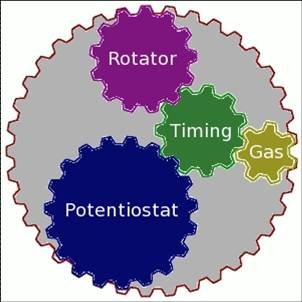
Automated Rotating Disc Electrode Setup

A Rotating Disk Electrode (RDE) allows the precise control of mass transport of reacting species to the electrode surface in an electrochemical setup. It therefore enables us to distinguish between mass transport and reaction kinetics. Although the basic equations for the RDE were solved already half a century ago by Levich, the RDE still remains the most widely used methodology in electrochemistry. In the 90’s an RDE approach was used for the first time for activity measurements of the oxygen reduction reaction (ORR) on high surface area catalysts (HSACs), which are used in real fuel cell systems and since then the RDE methodol ogy is the state-of-the-art procedure for activity measurements of HSACs.
Despite its role as a workhorse in electrochemistry and electrocatalysis in particular, RDE setups are usually controlled manually, which is time-consuming and a source of error for measurements for which exact timing is crucial.
Our group has developed a modular LabVIEW-based computer software that allows complete automation of all standard RDE measurements [1]. This software enables the simultaneous control of the potentiostat, the gas flow and the rotator unit whereas the experiment can be programmed in advance, using a worklist. Therefore, standard measurements can be performed in a completely automated fashion and the experiments can be reproduced by using a defined worklist for different catalysts.
